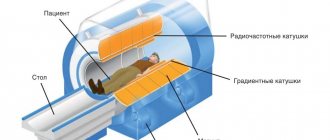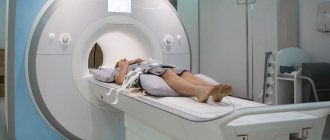What should be the normal size of the thyroid gland in women? Below is a table with all its parameters, it can be
. The thyroid gland is one of the most important endocrine glands. This organ produces vital hormones, so the slightest disturbance in the functioning of the thyroid gland can lead to serious disruptions in the functioning of the entire body.
In children, congenital deficiency of thyroid hormones can be accompanied by retardation in physical and mental development, brain damage (up to the development of cretinism), trophic skin disorders, etc.
In adults, a decrease in the synthesis of thyroid hormones manifests itself:
- swelling;
- damage to the cardiovascular system (severe heart rhythm disturbances, abnormally low blood pressure, etc.);
- neurological disorders (decreased intelligence, impaired skin sensitivity, impaired reflexes, etc.);
- anemic symptoms;
- hearing loss;
- infertility;
- decreased libido;
- menstrual disorders (in women, symptoms of a lack of thyroid hormones often manifest as irregular menstruation or their complete disappearance), etc.
With an increase in the level of secretion of thyroid hormones, life-threatening arrhythmias, persistent attacks of tachycardia, the development of gynecomastia in men and amenorrhea in women, weight loss, the appearance of paroxysmal abdominal pain, diarrhea, constant irritability, memory loss, etc. are noted.
Signs of thyroid disease
Symptoms of thyroid diseases depend on the type of pathological changes occurring in the endocrine system. They can be acute, subacute and chronic. Women with hypothyroidism (decreased thyroid function) experience:
- constant weakness;
- depressed mood;
- bowel dysfunction;
- irregular menstruation;
- cold intolerance;
- swelling of the face and limbs.
With hyperthyroidism (thyrotoxicosis), when the thyroid cells produce more than the required norm of iodine-containing hormones, in women:
- subfebrile temperature rises and remains at 37-38°C;
- convulsions appear;
- menstruation becomes heavy and painful;
- dry skin increases;
- drowsiness, irritability, anxiety appear;
- there is indifference to sexual life.
Goiter is the main sign of pathology of the endocrine system. Such a deviation from the normal thyroid gland cannot be ignored or attributed, like other symptoms, to a cold or stress. The pathology can be diffuse, nodular or mixed. Deviations from the norm are manifested by swelling in the neck, discomfort when swallowing, and difficulty breathing.
Anatomical features of the gland
The thyroid gland consists of two parts (right, left lobe) and an isthmus that connects them. The isthmus is located at the level of 2-3 cartilaginous rings of the trachea. Normally, the right lobe is slightly larger than the left. In some people, the isthmus is absent, or a third additional lobe (pyramidal) is present, which is also considered normal.
The shape of the thyroid gland is similar to a butterfly, the wings of which cover the trachea. If it resembles the letter H or half of the moon with its ends raised up, such shapes are also considered normal.
Parameters determined using ultrasound
During an ultrasound examination of the thyroid gland, attention is paid to the following characteristics:
- homogeneity and echogenicity of glandular tissue;
- functional state of blood vessels;
- iliac and transverse dimensions of the left and right lobes, isthmus;
- total volume of the gland;
- the presence of cysts or neoplasms;
- condition of neighboring anatomical organs.
Sometimes the patient is asked to perform a Valsalva maneuver (an attempt to exhale with the larynx closed), which makes it possible to study the nature of the venous outflow in the superior jugular vein basin.
How to determine the size of the thyroid gland
The endocrine organ is located shallow under the skin, so you can notice deviations from the norm in its size and structure yourself.
At home
You can detect abnormalities in the size of the thyroid gland by swallowing water:
- Stand in front of the mirror.
- Take a mouthful of water.
- Take several sips in a row.
- Look in the mirror and observe whether swelling appears in the thyroid area during swallowing.
If the test result is positive, it means the thyroid gland is enlarged.
The exact size and volume of the thyroid gland are of important diagnostic importance. Indicators are determined by ultrasound.
On ultrasound
An ultrasound examination is prescribed after donating blood to check the level of thyroid hormones. Ultrasound allows:
- establish the exact dimensions, volume of the lobes and isthmus;
- evaluate the contours of the thyroid lobes;
- identify pathology of lymphatic and blood vessels;
- determine the structure and echogenicity (degree of sound transmission) of glandular tissue.
If, according to ultrasound results, the size of the thyroid gland in women is deviated more from the norm, then the endocrinologist faces a difficult task. The specialist must make a diagnosis, taking into account the fact that a similar symptom can occur in a number of diseases. These include kidney and liver failure, chronic obstructive pulmonary disease and other conditions.
Preparation and conduct of the study
Ultrasound examination of the thyroid gland does not require special preparation. It is also safe to perform during pregnancy, since ultrasound waves do not affect the development of the fetus.
Preparation is only necessary if an additional examination of the abdominal organs is performed. In the first case, the patient is prescribed a diet for several days. Avoid products that contribute to gas formation and stagnation of feces (fresh bread, carbonated drinks, alcohol, legumes, milk, raw vegetables and fruits). If necessary, a cleansing enema is given 12 hours before. The study itself is carried out in the morning on an empty stomach.
It is very important to prepare the child psychologically for the study. It is necessary to convincingly tell that this procedure is absolutely painless and will not cause any discomfort. It should be remembered that children are often sensitive to the emotions of their parents, and therefore you need to remain calm and have a positive attitude.
Ultrasound is performed by a functional diagnostics doctor. Sometimes the thyroid gland is examined directly by an endocrinologist who has undergone special training.
The patient frees his neck from clothing (if necessary, remove a sweater or shirt with a high collar) and lies down on the couch. A special gel is applied to the surface of the neck, which improves the passage of ultrasonic waves. After which the doctor places a sensor and sequentially examines the lobes of the gland and the isthmus. The study is carried out using a linear sensor. An example of an image of the gland is shown in the following photo.
The duration of the study does not exceed 10-15 minutes. After its completion, remove the gel from the surface of the neck using disposable towels. The result is delivered to the patient almost immediately, or sent to the specified email.
What does a healthy thyroid gland look like on ultrasound?
The normal thyroid gland according to ultrasound is characterized by:
- Pronounced contours of the lobes and isthmus.
- The tissue structure is the same; the follicles of which it consists do not exceed 2 mm in diameter.
- Normal echogenicity, which is equal to the echogenicity of the parotid salivary gland.
- The presence of several color signals (Doppler ultrasound) on the surface of the parenchyma, indicating a healthy blood supply to the tissue.
During the ultrasound examination, the doctor also takes into account the health of the cervical lymph nodes. In the normal state of the thyroid gland, they have clear contours and a length that is twice their width. In the structure of the lymph nodes, the gate into which the lymphatic vessels enter is clearly visible.
Conclusion
The thyroid gland takes part in regulating the functioning of internal organs. In a healthy woman weighing 60 kilograms, the thyroid gland normally does not exceed 19 cubic centimeters.
If the size of the thyroid gland is larger, they speak of an increased volume of the thyroid gland.
This may indicate the presence of pathological processes in the body. To confirm or refute fears, doctors prescribe an ultrasound examination of the thyroid gland.
You can read the test result yourself, but then you must take it to an endocrinologist.
Normal sizes and degrees of enlargement of the thyroid gland: tables
Before the advent of ultrasound, deviations in the thyroid gland from the norm were determined visually and by palpation.
According to WHO classification
In 2001, the World Health Organization approved the following classification of goiter according to severity and palpability:
- Zero degree - normal volume of the thyroid gland.
- The first is that the goiter is not noticeable, but is palpable.
- Second, deviations from the norm are clearly visible along the deformed contours of the neck, the organ can be clearly palpated.
According to Nikolaev
In the middle of the 20th century, deviations in size from the norm were verified according to Nikolaev:
- I degree - the organ is palpable and has normal dimensions.
- II - becomes visible when swallowing.
- III - the “thick neck” effect is observed.
- IV - the contour of the neck is deformed.
- V - the thyroid gland enlarges so much that it makes breathing and swallowing difficult.
By ultrasound
In adults, the lobes of the thyroid gland are normal with the following values:
| Length(cm) | Width(cm) | Thickness(cm) | Isthmus (mm) |
| 2,5—4 | 1,5—2 | 1—1,5 | 4—8 |
The right thyroid lobe may be slightly larger than the left. Guideline values vary depending on the body weight and gender of individuals. Pregnant women have their own rules. As a rule, they are several units higher.
Norms for thyroid volume in women compared to men:
| Weight, kg) | Norm (cm3) Women | Norm (cm3) Men |
| 50 | 15 | 18 |
| 60 | 18 | 20 |
| 70 | 21 | 23 |
| 80 | 25 | 28 |
| 90 | 28 | 30 |
| above 100 | 32 | 34 |
The volume of the thyroid gland in men is always larger, which is explained by the physiological characteristics of their body.
Age also matters.
From birth to 16-18 years of age, the endocrine organ gradually grows. Its increase is most often observed during puberty.
Reasons for organ changes on ultrasound
Pathology of glandular tissue most often develops against the background of genetic predisposition, hormonal imbalance, autoimmune and endocrine diseases.
Resizing
Both deficiency and excess of iodine in the body can lead to enlargement and reduction of the thyroid gland. Often the size of the thyroid gland changes under the influence of antibodies of the immune system, which destroy its cells.
Enlargement or hyperplasia
The volume of the thyroid gland increases due to the proliferation of its follicular cells. Hyperplasia can be autoimmune and compensatory in nature. The latter case is inherent in hypothyroidism (iodine deficiency state). When the thyroid gland enlarges, it tries to capture more iodine from the bloodstream. With hyperthyroidism (excess of iodine-containing hormones), hyperplasia occurs against the background of increased thyroid function.
Reduction, or hypoplasia
If underdevelopment of the endocrine gland appears immediately after birth, the pathology is considered congenital. The reasons for this hypoplasia are associated with a lack of iodine in the pregnant woman’s body and her existing thyroid problems.
Acquired hypoplasia is diagnosed as atrophy. The gradual death of thyrocytes leads to shrinkage of the thyroid gland. Hypothyroidism develops due to a lack of hormones.
Change of structure
Thyroid tissue parameters can change the following pathologies:
- Diffuse (widespread) and nodular toxic goiter. Pathology develops when all cells of the gland or its individual sections intensively produce hormones.
- Colloid goiter. It is characterized by a violation of the outflow of colloidal substances from the follicles of the organ. One node is considered normal. A goiter is diagnosed in the presence of two or more neoplasms.
- Hypothyroidism. Occurs due to decreased thyroid function.
- Thyroiditis. Bacterial / viral inflammation of the organ parenchyma. Usually the infection enters the tissues from the respiratory tract.
- Neoplasms of malignant and benign nature.
Reasons for the increase
It is important to know the factors that provoke an enlarged thyroid gland:
- deficiency of iodine, magnesium, selenium, fluorine,
- long-term use of certain medications that contain substances that suppress the secretion of thyroid hormones,
- frequent consumption of soybeans, turnips,
- bacterial infections that reduce the functionality of the thyroid gland,
- deficiency of vitamins, including group B and calciferol,
- difficult environmental situation,
- stressful situations, chronic fatigue,
- diseases of the hypothalamus and pituitary gland, against the background of which the secretion of hormones that control and regulate the functions of the thyroid gland is disrupted,
- genetic predisposition to endocrine pathologies.
Treatment methods
The endocrinologist draws up an individual treatment regimen taking into account the physiological state of the person, age, and the degree of deviation of the thyroid gland size from the norm. An important place in complex treatment is given to proper nutrition. With different types of goiter, patients require different menus.
Surgery
The need to remove the thyroid gland (complete or partial resection) appears if:
- malignant neoplasms;
- large non-oncological tumors;
- neoplasms that interfere with breathing.
Drug therapy
If the normal size of the thyroid gland is changed due to hypothyroidism (decreased function), replacement therapy is prescribed. Treatment consists of taking (often lifelong) thyroid hormones.
To combat increased thyroid function (hyperthyroidism, thyrotoxicosis), medications are prescribed that suppress the functioning of follicular cells. This is Mercazolil, Methimazole.
If deviations from the norm in the functioning of the thyroid gland are provoked by viruses or bacteria, then antibiotics (Ceftriaxone, Penicillin) are included in complex therapy. Treatment lasts 7-10 days.
Treating thyroid disease with home remedies is dangerous. You can drink decoctions and infusions based on medicinal herbs only with the permission of an endocrinologist.
Deviations from the norm in the structure and functions of the thyroid gland are treated only with medication. Folk remedies cannot replace therapy prescribed by a doctor.
What are the dangers of changing the size and structure of the thyroid gland?
If left untreated, the thyroid gland will gradually increase in size, which will subsequently lead to constriction of the throat and difficulty breathing. Against the background of oxygen starvation, the body begins to experience a lack of energy. First of all, the lack of oxygen affects the functioning of the brain. A person’s memory deteriorates, blood pressure drops, and diseases of the nervous and cardiovascular systems develop.
With normal functioning, a reduced thyroid gland is not dangerous to human life. But in unexamined patients, long-term hypoplasia can cause an acute lack of thyroid hormones in the body. Such a person gets tired quickly, he constantly wants to sleep, he has no desire for life.
Volume Changes
Changes in the volume of the thyroid gland are especially typical for regions with low iodine content in food products. To compensate for the lack of this microelement, the gland enlarges (hyperplasia). The volume also increases during acute inflammatory processes (due to edema), neoplasms and cysts.
The most common cause of decreased thyroid volume is congenital hypo- or aplasia, as well as a condition where the patient previously had one of the lobes removed.











